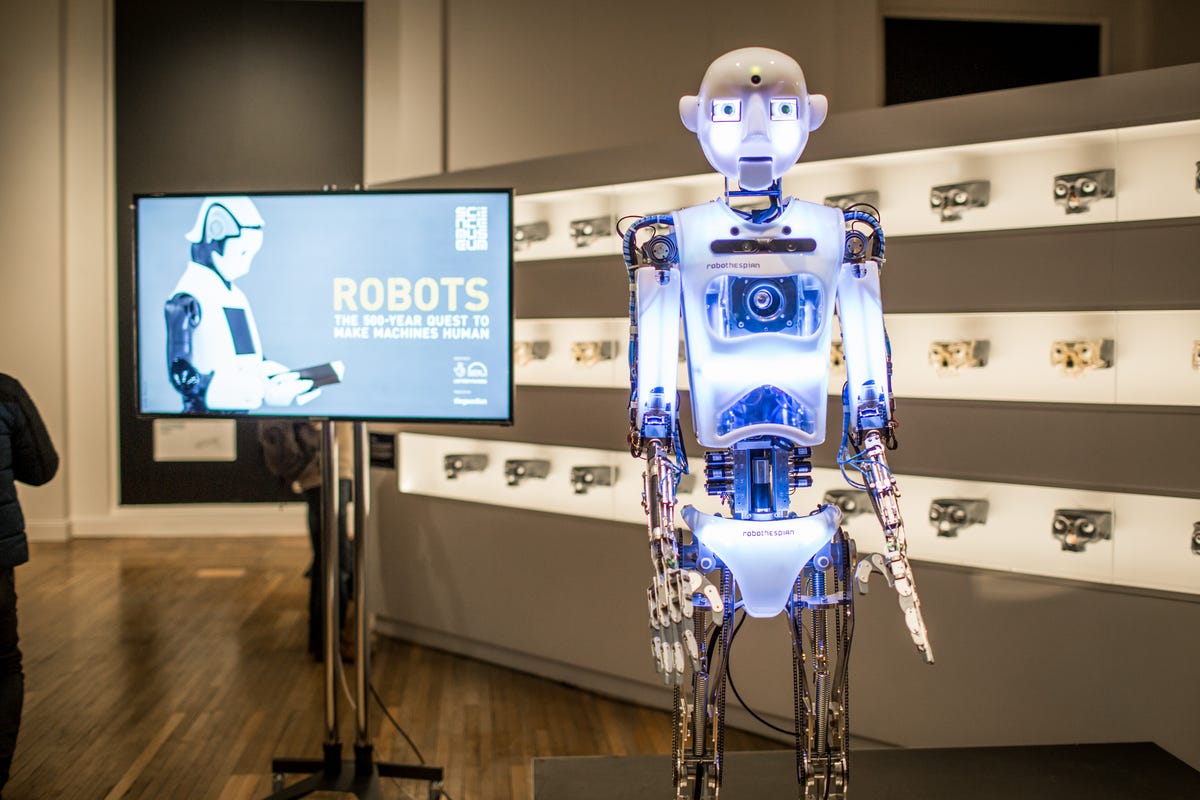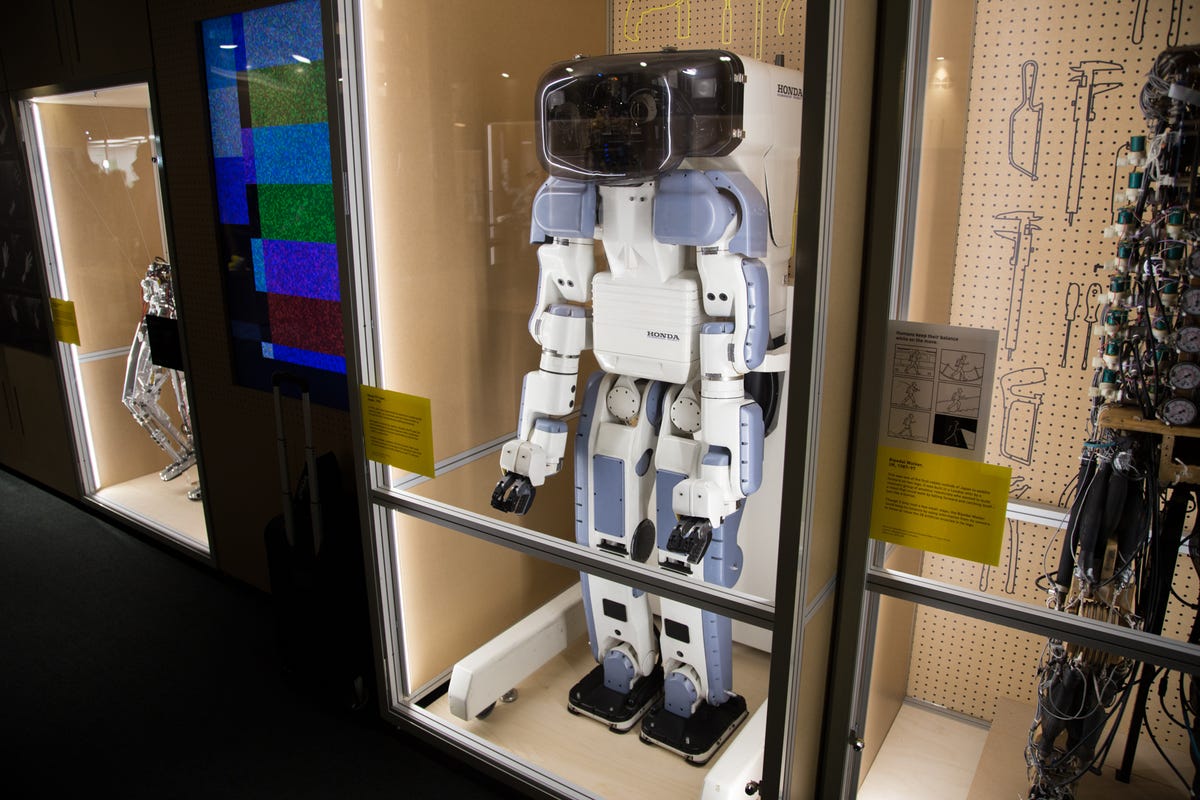In 500 years, robots haven't become any less creepy
Go inside a brilliant new exhibition at London's Science Museum where robots hundreds of years old prove they've always been pretty unnerving.

RoboThespian
Meet RoboThespian, the robotic actor. It's one of the first smiling faces you see upon entering the new "Robots" exhibit at London's Science Museum.
The exhibit is home to a wide variety of mechanical folk, some dating back hundreds of years. I took an early look around to see which robots from the centuries gone by frightened me the most.
The exhibition opens Wednesday and runs until Sept. 3.
RoboThespian sings
RoboThespian moves, sings, jokes and interacts with the audience in a manner that's frankly far better than most CEOs manage during a keynote speech.
He was totally unfazed by the world's media shoving their cameras in his face, even managing to belt out a few lines from his favourite song, "Singing in the Rain."
Clockwork monk
The exhibit dives back through the centuries to the earliest example of what we might call a robot. This clockwork model of a monk dates to about the year 1560. It was, according to the curators, able to walk across the table, move his lips, raise a crucifix and "beat his chest with contrition."
A robot Jesus
If the clockwork monk didn't put the fear of god in you, then maybe Robot Jesus will. This statue used clockwork to allow Jesus to "cry" blood (actually pieces of red-painted wood) from wounds on his body. Surely a delightful piece to bring out at Easter.
Silver swan
This life-size silver swan -- known, unsurprisingly, as "the silver swan" -- dates back to around 1773 and uses clockwork to turn various moving parts. Numerous glass spiral tubes rotate and 'sparkle' to give the effect of rippling water, small silver fish jump and dive about and the swan turns its long neck to peck fish from the 'water'.
Mark Twain once viewed and wrote about the same swan.
Silver swan
The wind-up bird performs a 37-second routine to music. There will be one demonstration a day of the silver swan until it is removed from the exhibition at the end of March.
Kaspar
While it's certain that Kaspar here will haunt my sleep forever, he actually serves a useful purpose. He's designed for children with autism, allowing them to learn to recognise and respond to basic facial expressions.
Kaspar
Kaspar has touch-sensitive skin, allowing him to respond with "ow!" if the child is too rough in their play.
Take a moment to look again at this photo and let the fact that it can feel pain sink in.
Rebuilding Eric
This is an exact re-creation of the UK's first robot, Eric, built originally in 1928. The rebuild was funded by a Kickstarter campaign that raised over £50,000.
It's interesting to note, while you're looking at his razor-sharp teeth, that the original Eric robot was never found, following his world tour.
A '50s-era robot
This large chap from the US looks quite stereotypical of the '50s era in which he was built.
Robot roundup
Weirdest family portrait ever.
Robot baby
I really don't know what this lifelike robot baby was doing, or why it was bolted to the wall, squirming slightly.
Prosthetic arm
This is one of a variety of prosthetic arms on show, dating from 1500-1700. Armourers were known to make such creations for soldiers who lost their limbs in battle.
Prosthetic hand
Prosthetics have come a long way, with companies like Open Bionics using modern materials, 3D printing and extremely advanced microelectronics to help people of all ages replace missing limbs.
A robot you can play with
You can find a variety of robot toys on display in the exhibit.

Honda P2 robot
The Honda P2 robot was the world's first independently walking humanoid. It's able to walk across a stage and climb stairs without supports of any kind.
It took 10 years of development before the P2 was finally shown off in 1996.
Pepper
This cutie goes by the name of Pepper and was developed in 2014 as a 'social robot', designed to welcome visitors at public spaces.
Nexi 21
Nexi's 21 facial features are all computer controlled, allowing it to mimic a variety of human expressions to study people's responses to it.
I imagine a large proportion of responses could be categorised under 'fear'.
All eyes are on you
This large wall of robot skull sections all have moving eyes, with motion sensors that allow the eyes to follow the path of whoever walks in front.
So that's nice.
Babybot
Babybot, complete with paper lips and tennis balls for eyes, learned hand-eye coordination by picking up and exploring objects around it -- just like a real human baby. Hopefully all weapons are out of reach.
Zeno
Zeno can make a variety of lifelike facial expressions. It's aimed at helping children with learning difficulties figure out how to recognise such expressions and how to interact with them.
Telenoid
And now we're straight back to creepy again with Telenoid.
Made in Japan, Telenoid is sold as a "communication avatar" which in short means it's a stand-in for your real-life partner. The idea is that if your partner on the other side of the world gives their Telenoid a hug, then your Telenoid will hug you in much the same way.
In doing so, you'll hopefully be tricked into thinking that this squirming, limbless, expressionless thing is in fact your beloved.
Inkha
Inkha was designed to use its expressive face to greet visitors at Kings College London with a sassy attitude.
The Science Museum exhibit sign explains "Inkha does not feel emotions," which presumably includes remorse at, say, committing an unpleasant crime.
Harry, the trumpet player
Using nimble fingers and compressed air, Harry can actually play this trumpet. He is able to independently walk too, and apparently can sway his hips to his music.
He's almost certainly off to only the coolest jazz bars once the exhibition closes in September.
REEM prototypes
Check out a variety of early REEM prototypes, which are all designed as public speaking robots. REEM robots have been seen as receptionists, greeters and masters of ceremonies.
ASIMO
World-famous ASIMO is on display too. This little chap is the most advanced humanoid robot, capable of running, jumping, kicking footballs, recognising faces, grasping and using objects and a variety of other things I have little ability to do after a beer.
Kodomoroid
Kodomoroid is among the most lifelike robots around, and has been put to work as a newsreader.
Amico
Amico is a great demonstration of robots' ability to handle and manipulate small objects -- in this case, fitting small parts into car engines.
Baxter
Similarly, Baxter here is designed for factory or laboratory work. With its two arms, it can work alongside humans laborers who are able to teach Baxter what to do. Presumably, the humans are then no longer needed.

